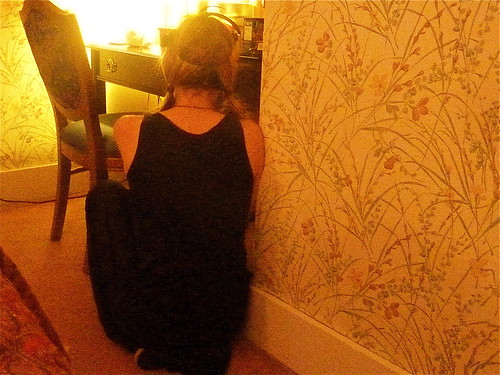Yellow Wallpaper Quotes Biography
Source(Google.com.pk)Charlotte Perkins Gilman was an eminent American writer of non-fiction and short stories, novelist, feminist social reformer, lecturer and commercial artist.
Born in Hartford, Connecticut in 1860, Charlotte Anne Perkins was related through her father Beecher to the famous Lyman Beecher, Henry Ward Beecher, Catherine Beecher and Harriet Beecher Stowe. Soon after she was born, young Charlotte’s father (an accomplished writer) abandoned her mother and left her to raise Charlotte and her older brother. Impoverished, and without means of support except for the infrequent appearances of her wayward husband, Charlotte’s mother spent time living with various family members in Rhode Island. She often left Charlotte in the care of her aunts – Catherine Beecher whose brand of “domestic feminism” would come to be seen as no better than domestic slavery by her niece; Isabella Beecher Hooker, whose suffragist activism inspired her neice; and Harriet Beecher Stower, the famous author of Uncle Tom's Cabin and champion of abolition whose failure to apply the same standards to the treatment of women would be corrected by the actions of her niece.
Charlotte’s mother did not show her children any affection in an effort to prepare them for what she perceived as the world’s callousness. She would, however, display signs of affection when she thought her daughter was sleeping and unaware of her mother’s attention. Young Charlotte was intelligent and taught herself to read through frequent trips to the public libraries. She attended public schools until she was fifteen and, though she impressed her teachers with the power of her mind, she failed to perform as a student. She was deeply interested in subjects which would later come to be identified with the emerging discipline of Sociology. Because the subjects that fired her interested the most were strictly the prevue of male scholars, however, Perkins chose to study art at the Rhode Island School of Design where she supported herself by making trade cards. During this time she also dabbled in painting and tutored young students.
At the age of 24, Charlotte reluctantly married Charles Stetson, an artist whose proposal she had initially declined. A year later they had a baby girl, named Katharine Beecher Stetson, and Charlotte began to suffer from depression. After three years of suffering, which a trip to Pasadena, CA did little to abate, Charlotte agreed to undergo the “rest” treatment being espoused by Dr. S. Weir Mitchell, a leading physician of the day. The treatement included:
bed rest
isolation
overfeeding to increase body weight
massage and occasional use of electricity to stimulate the muscles
It was an extreme method intended to bring about the same state of patient dependence upon the clinician as being practiced by the Freudians in Europe. In the initial stage of the “rest” treatment, the patient could not leave her bed, sew, talk, read, write or even feed herself.
Mitchell’s instructions to Gilman after a month under his care were to return home and “Live as domestic a life as possible. Have your child with you all the time. . . . Lie down an hour after each meal. Have but two hours’ intellectual life a day. And never touch pen, brush or pencil as long as you live.”
It was too much for Charlotte and in 1888 she fled her husband and doctor to resettle in California. She began to be active as a suffragist lecturer. In 1892 she wrote her most enduring work, a short story critique of her experience under Mitchell’s care entitled “The Yellow Wallpaper” but it was her first book of poems In This Our World (1893) that established her as a writer. In 1894 she divorced Charles Stetson and sent her daughter back East to live with her ex-husband and his new wife, a friend of Charlotte’s whom she considered as, if not more, capable of raising young Katherine.
From 1894-1895 she served as the editor of the Impress, a feminist literary magazine and in 1897 she completed work on her groundbreaking Women and Economics (1898), in which she espoused that only by achieving economic independence could women truly achieve equality with men.
Gilman’s married her first cousin, a New York attorney named George Houghton Gilman, in 1900. Gilman’s notoriety as a leading lecturer on women’s rights coupled with the success of Women and Economics led to her inclusion in the International Congress of Women held in Berlin in 1903 and subsequent speaking tours of England and Europe.
From 1909-1916, she edited and published her own magazine The Forerunner in which many of her works first appeared, including: What Diantha Did, (1910), The Crux, (1911), Moving the Mountain, (1911), and Herland (1915).
Though her marriage to George Houghton Gilman was increasingly unhappy, they did not divorce. Rather, Charlotte moved from New York to her husband’s homestead in Norwich, CT.
Charlotte Perkins Gilman’s lectures and writings such as “The Home” (1903), Human Work (1904), and The Man-Made World (1911), reveal the mind of an avid humanist dedicated to equality of the sexes. Among her groundbreaking theories were:
Women are subjugated by men
Becoming a mother should not prevent a woman from working outside the home
In the future, tasks such as cooking, child care and housekeeping would be taken care of by professionals
Men and women should share housekeeping duties
Young girls should be encouraged to think independently
Following her husband’s death in 1934, Gilman returned to Pasadena to be with her daughter. An advocate of voluntary euthanasia, Gilmanor many years I suffered from a severe and continuous nervous breakdown tending to melancholia—and beyond. During about the third year of this trouble I went, in devout faith and some faint stir of hope, to a noted specialist in nervous diseases, the best known in the country. This wise man put me to bed and applied the rest cure, to which a still good physique responded so promptly that he concluded that there was nothing much the matter with me, and sent me home with solemn advice to 'live as domestic a life as possible,' to 'have but two hours' intelligent life a day,' and 'never to touch pen, brush or pencil again as long as I lived.' This was in 1887…"
—Charlotte Perkins Gilman, "Why I Wrote the Yellow Wall-paper," 1913
"Every kind of creature is developed by the exercise of its functions. If denied the exercise of its functions, it can not develop in the fullest degree."
—Charlotte Perkins Stetson (Gilman),
from Hearing of the National American Woman Suffrage Association. Committee on the Judiciary, House of Representatives, Washington, D.C., January 28, 1896
Charlotte Perkins Gilman's story "The Yellow Wall-paper" was written during a time of great change. In the early- to mid-nineteenth century, "domestic ideology" positioned American middle class women as the spiritual and moral leaders of their home. Such "separate spheres" ideals suggested that a woman's place was in the private domain of the home, where she should carry out her prescribed roles of wife and mother. Men, on the other hand, would rule the public domain through work, politics, and economics. By the middle of the century, this way of thinking began to change as the seeds of early women's rights were planted. By the end of the 1800s, feminists were gaining momentum in favor of change. The concept of "The New Woman," for example, began to circulate in the 1890s-1910s as women pushed for broader roles outside their home-roles that could draw on women's intelligence and non-domestic skills and talents.
Gilman advocated revised roles for women, whom, Gilman believed, should be on much more equal economic, social, and political footing with men. In her famous work of nonfiction Women and Economics (1898), Gilman argued that women should strive-and be able-to work outside the home. Gilman also believed that women should be financially independent from men, and she promoted the then-radical idea that men and women even should share domestic work.
First appearing in the New England Magazine in January 1892, "The Yellow Wall-paper," according to many literary critics, is a narrative study of Gilman's own depression and "nervousness." Gilman, like the narrator of her story, sought medical help from the famous neurologist S. Weir Mitchell. Mitchell prescribed his famous "rest cure," which restricted women from anything that labored and taxed their minds (e.g., thinking, reading, writing) and bodies. More than just a psychological study of postpartum depression, Gilman's "The Yellow Wall-paper" offers a compelling study of Gilman's own feminism and of roles for women in the 1890s and 1910s.
This lesson plan, the second part of a two-part lesson, should be completed after students examine and understand the historical, social, cultural, and economic context of Gilman's story in Lesson One. This lesson requires a close reading of "The Yellow Wall-paper" itself within the context of students' research and analysis in the first part of the full lesson. This lesson is also suitable as a stand-alone lesson plan focusing on a close reading of Gilman's story, exploring such literary concepts as setting, narrative style, symbol, and
Yellow Wallpaper Quotes Wallpapers Quotes For Iphone Tumblr Life1 Hd Funny Love For Mobile On Sad Love Happiness For Cell Phones

Yellow Wallpaper Quotes Wallpapers Quotes For Iphone Tumblr Life1 Hd Funny Love For Mobile On Sad Love Happiness For Cell Phones

Yellow Wallpaper Quotes Wallpapers Quotes For Iphone Tumblr Life1 Hd Funny Love For Mobile On Sad Love Happiness For Cell Phones

Yellow Wallpaper Quotes Wallpapers Quotes For Iphone Tumblr Life1 Hd Funny Love For Mobile On Sad Love Happiness For Cell Phones

Yellow Wallpaper Quotes Wallpapers Quotes For Iphone Tumblr Life1 Hd Funny Love For Mobile On Sad Love Happiness For Cell Phones
Yellow Wallpaper Quotes Wallpapers Quotes For Iphone Tumblr Life1 Hd Funny Love For Mobile On Sad Love Happiness For Cell Phones
Yellow Wallpaper Quotes Wallpapers Quotes For Iphone Tumblr Life1 Hd Funny Love For Mobile On Sad Love Happiness For Cell Phones

Yellow Wallpaper Quotes Wallpapers Quotes For Iphone Tumblr Life1 Hd Funny Love For Mobile On Sad Love Happiness For Cell Phones
Yellow Wallpaper Quotes Wallpapers Quotes For Iphone Tumblr Life1 Hd Funny Love For Mobile On Sad Love Happiness For Cell Phones

Yellow Wallpaper Quotes Wallpapers Quotes For Iphone Tumblr Life1 Hd Funny Love For Mobile On Sad Love Happiness For Cell Phones

Yellow Wallpaper Quotes Wallpapers Quotes For Iphone Tumblr Life1 Hd Funny Love For Mobile On Sad Love Happiness For Cell Phones

Yellow Wallpaper Quotes Wallpapers Quotes For Iphone Tumblr Life1 Hd Funny Love For Mobile On Sad Love Happiness For Cell Phones

Yellow Wallpaper Quotes Wallpapers Quotes For Iphone Tumblr Life1 Hd Funny Love For Mobile On Sad Love Happiness For Cell Phones

Yellow Wallpaper Quotes Wallapers Quotes For Iphone Tumblr Life1 Hd Funny Love For Mobile On Sad Love Happiness For Cell Phones

No comments:
Post a Comment